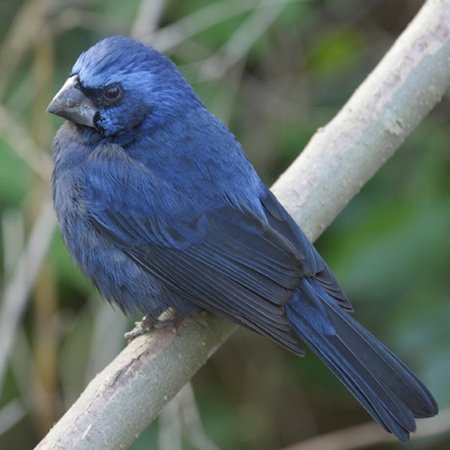Cardinalidae – Cardinals, Grosbeaks & Allies

Cardinals & Grosbeaks in the family Cardinalidae, are passerine birds found in North and South America. They are also known as cardinal-grosbeaks and cardinal-buntings. The South American cardinals in the genus Paroaria are placed in another family, the Thraupidae (previously placed in Emberizidae).
They are robust, seed-eating birds with strong bills. The family ranges in size from the 12-cm, 11.5-g orange-breasted bunting and up to the 25-cm, 85-g black-headed saltator. They are typically associated with open woodland. The sexes usually have distinctive appearances. The northern cardinal type species was named by colonists for the male’s red crest, reminiscent of a Catholic cardinal’s biretta.
The “North American buntings” are known as such to distinguish them from buntings. The name “cardinal-grosbeak” can also apply to this family as a whole.
Most species are rated by the IUCN as being of least concern, though some are near threatened.
According to the IOC there are 53 species in this family including some Tanagers, Cardinals, Grossbeaks, Seedeaters and Buntings. They are:
Flame-colored Tanager Piranga bidentata
Tooth-billed Tanager Piranga lutea
Red Tanager Piranga flava
Hepatic Tanager Piranga hepatica
Summer Tanager Piranga rubra
Rose-throated Tanager Piranga roseogularis
Scarlet Tanager Piranga olivacea
Western Tanager Piranga ludoviciana
White-winged Tanager Piranga leucoptera
Red-headed Tanager Piranga erythrocephala
Red-hooded Tanager Piranga rubriceps
Red-crowned Ant Tanager Habia rubica
Red-throated Ant Tanager Habia fuscicauda
Black-cheeked Ant Tanager Habia atrimaxillaris
Sooty Ant Tanager Habia gutturalis
Crested Ant Tanager Habia cristata
Carmiol’s Tanager Chlorothraupis carmioli
Olive Tanager Chlorothraupis frenata
Lemon-spectacled Tanager Chlorothraupis olivacea
Ochre-breasted Tanager Chlorothraupis stolzmanni
Yellow Grosbeak Pheucticus chrysopeplus
Black-thighed Grosbeak Pheucticus tibialis
Golden Grosbeak Pheucticus chrysogaster
Black-backed Grosbeak Pheucticus aureoventris
Rose-breasted Grosbeak Pheucticus ludovicianus
Black-headed Grosbeak Pheucticus melanocephalus
Red-breasted Chat Granatellus venustus
Grey-throated Chat Granatellus sallaei
Rose-breasted Chat Granatellus pelzelni
Northern Cardinal Cardinalis cardinalis
Vermilion Cardinal Cardinalis phoeniceus
Pyrrhuloxia Cardinalis sinuatus
Black-faced Grosbeak Caryothraustes poliogaster
Yellow-green Grosbeak Caryothraustes canadensis <
Crimson-collared Grosbeak Rhodothraupis celaeno
Red-and-black Grosbeak Periporphyrus erythromelas
Cabanis’s Seedeater Amaurospiza concolor
Ecuadorian Seedeater Amaurospiza aequatorialis
Blackish-blue Seedeater Amaurospiza moesta
Carrizal Seedeater Amaurospiza carrizalensis
Dickcissel Spiza americana
Glaucous-blue Grosbeak Cyanoloxia glaucocaerulea
Blue-black Grosbeak Cyanocompsa cyanoides
Rothschild’s Grosbeak Cyanocompsa rothschildii
Ultramarine Grosbeak Cyanocompsa brissonii
Blue Bunting Cyanocompsa parellina
Blue Grosbeak Passerina caerulea
Indigo Bunting Passerina cyanea
Lazuli Bunting Passerina amoena
Varied Bunting Passerina versicolor
Painted Bunting Passerina ciris
Rose-bellied Bunting Passerina rositae
Orange-breasted Bunting Passerina leclancherii
-
Northern Cardinal Cardinalis cardinalis
BirdLife Species AccountThe population size is extremely large, and hence does not approach the thresholds for Vulnerable under the population size criterion (<10,000 mature individuals with a continuing decline estimated to be >10% in ten years or three generations, or with a specified population structure). For these reasons the species is evaluated as Least Concern. -
Northern Cardinal Cardinalis cardinalis
Species AccountThe northern cardinal (Cardinalis cardinalis) is a North American bird in the genus Cardinalis; it is also known colloquially as the redbird or common cardinal. It can be found in southern Canada, through the eastern United States from Maine to Texas and south through Mexico. It is found in woodlands, gardens, shrublands, and swamps. -
Northern Cardinal Cardinalis cardinalis
Cornell Species AccountThe male Northern Cardinal is perhaps responsible for getting more people to open up a field guide than any other bird. They’re a perfect combination of familiarity, conspicuousness, and style: a shade of red you can’t take your eyes off. -
Rose-breasted Grosbeak Pheucticus ludovicianus
BirdLife Species AccountBirdLife species profile -
Rose-breasted Grosbeak Pheucticus ludovicianus
Species AccountSound archive and distribution map -
Rose-breasted Grosbeak Pheucticus ludovicianus
ABC Species AccountThe Rose-breasted Grosbeak is strikingly beautiful. But it has a gruesome folk name: “cut-throat,” owing to the scarlet swatch across its breast. The name “grosbeak” comes from the French term grosbec, meaning “large beak”—an obvious attribute of this bird, Black-headed Grosbeak, and others in their family. -
Rose-breasted Grosbeak Pheucticus ludovicianus
Species AccountThe rose-breasted grosbeak (Pheucticus ludovicianus) is a large seed-eating grosbeak in the cardinal family (Cardinalidae). It is primarily a foliage gleaner. It breeds in cool-temperate North America, migrating to tropical America in winter. -
Rose-breasted Grosbeak Pheucticus ludovicianus
Cornell Species AccountBursting with black, white, and rose-red, male Rose-breasted Grosbeaks are like an exclamation mark at your bird feeder or in your binoculars. Females and immatures are streaked brown and white with a bold face pattern and enormous bill.
-
Number of bird species: 53
